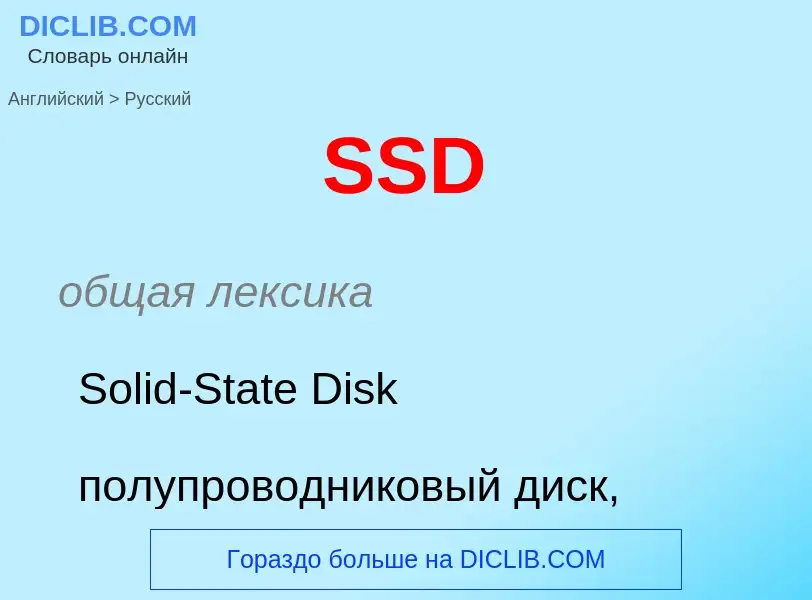Μετάφραση και ανάλυση λέξεων από τεχνητή νοημοσύνη
Σε αυτήν τη σελίδα μπορείτε να λάβετε μια λεπτομερή ανάλυση μιας λέξης ή μιας φράσης, η οποία δημιουργήθηκε χρησιμοποιώντας το ChatGPT, την καλύτερη τεχνολογία τεχνητής νοημοσύνης μέχρι σήμερα:
- πώς χρησιμοποιείται η λέξη
- συχνότητα χρήσης
- χρησιμοποιείται πιο συχνά στον προφορικό ή γραπτό λόγο
- επιλογές μετάφρασης λέξεων
- παραδείγματα χρήσης (πολλές φράσεις με μετάφραση)
- ετυμολογία
SSD - translation to ρωσικά
общая лексика
Solid-State Disk
полупроводниковый диск, твердотельный диск
['læmdəsiz(ə)m]
специальный термин
неправильное произношение звука r как l
замена звука r звуком l
существительное
специальный термин
неправильное произношение звука r как l
замена звука r звуком l
Βικιπαίδεια

A solid-state drive (SSD) is a solid-state storage device that uses integrated circuit assemblies to store data persistently, typically using flash memory, and functioning as secondary storage in the hierarchy of computer storage. It is also sometimes called a semiconductor storage device, a solid-state device or a solid-state disk, even though SSDs lack the physical spinning disks and movable read–write heads used in hard disk drives (HDDs) and floppy disks. SSD also has rich internal parallelism for data processing.
In comparison to hard disk drives and similar electromechanical media which use moving parts, SSDs are typically more resistant to physical shock, run silently, and have higher input/output rates and lower latency. SSDs store data in semiconductor cells. As of 2019, cells can contain between 1 and 4 bits of data. SSD storage devices vary in their properties according to the number of bits stored in each cell, with single-bit cells ("Single Level Cells" or "SLC") being generally the most reliable, durable, fast, and expensive type, compared with 2- and 3-bit cells ("Multi-Level Cells/MLC" and "Triple-Level Cells/TLC"), and finally quad-bit cells ("QLC") being used for consumer devices that do not require such extreme properties and are the cheapest per gigabyte (GB) of the four. In addition, 3D XPoint memory (sold by Intel under the Optane brand) stores data by changing the electrical resistance of cells instead of storing electrical charges in cells, and SSDs made from RAM can be used for high speed, when data persistence after power loss is not required, or may use battery power to retain data when its usual power source is unavailable. Hybrid drives or solid-state hybrid drives (SSHDs), such as Intel's Hystor and Apple's Fusion Drive, combine features of SSDs and HDDs in the same unit using both flash memory and spinning magnetic disks in order to improve the performance of frequently-accessed data. Bcache achieves a similar effect purely in software, using combinations of dedicated regular SSDs and HDDs.
SSDs based on NAND flash will slowly leak charge over time if left for long periods without power. This causes worn-out drives (that have exceeded their endurance rating) to start losing data typically after one year (if stored at 30 °C) to two years (at 25 °C) in storage; for new drives it takes longer. Therefore, SSDs are not suitable for archival storage. 3D XPoint is a possible exception to this rule; it is a relatively new technology with unknown long-term data-retention characteristics.
SSDs can use traditional HDD interfaces and form factors, or newer interfaces and form factors that exploit specific advantages of the flash memory in SSDs. Traditional interfaces (e.g. SATA and SAS) and standard HDD form factors allow such SSDs to be used as drop-in replacements for HDDs in computers and other devices. Newer form factors such as mSATA, M.2, U.2, NF1/M.3/NGSFF, XFM Express (Crossover Flash Memory, form factor XT2) and EDSFF (formerly known as Ruler SSD) and higher speed interfaces such as NVM Express (NVMe) over PCI Express (PCIe) can further increase performance over HDD performance. SSDs have a limited lifetime number of writes, and also slow down as they reach their full storage capacity.


![250 GB [[mSATA]] SSD with an external enclosure 250 GB [[mSATA]] SSD with an external enclosure](https://commons.wikimedia.org/wiki/Special:FilePath/14-06-11-ssd-RalfR-N3S 7886-03.jpg?width=200)





![An SSD that uses [[NVM Express]] as the logical device interface, in the form of a [[PCI Express 3.0]] ×4 [[expansion card]] An SSD that uses [[NVM Express]] as the logical device interface, in the form of a [[PCI Express 3.0]] ×4 [[expansion card]]](https://commons.wikimedia.org/wiki/Special:FilePath/Intel SSD 750 series, 400 GB add-in card model, top view.jpg?width=200)
![An [[M.2]] (2242) solid-state-drive (SSD) connected into [[USB]] 3.0 adapter and connected to computer. An [[M.2]] (2242) solid-state-drive (SSD) connected into [[USB]] 3.0 adapter and connected to computer.](https://commons.wikimedia.org/wiki/Special:FilePath/M.2 2242 SSD connected into USB 3.0 adapter.jpg?width=200)
![512 GB Samsung M.2 [[NVMe]] SSD 512 GB Samsung M.2 [[NVMe]] SSD](https://commons.wikimedia.org/wiki/Special:FilePath/SSD Samsung 960 PRO 512GB - front and back - 2018-05-27.jpg?width=200)




